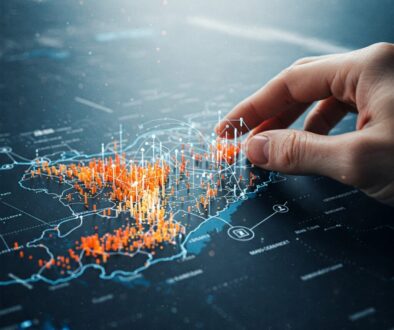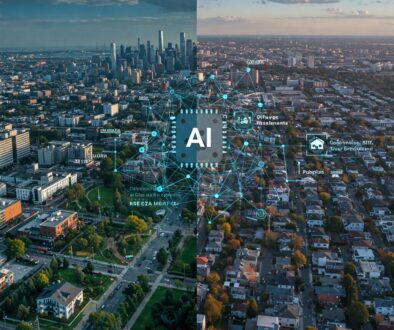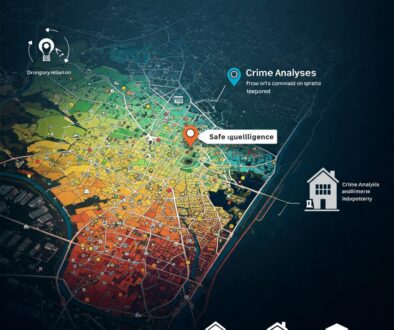5 Environmental Factors AI Can Detect That Human Surveyors Often Miss
When evaluating a property for investment, the environmental factors that impact its long-term value and viability can be some of the most difficult to assess. Traditional property surveys focus on visible, immediate conditions, often overlooking subtle environmental patterns and future risks that could significantly affect a property’s value and usability.
Modern AI-powered geospatial intelligence platforms like Locas.dev are changing this equation, offering unprecedented insights into environmental conditions that human surveyors frequently miss. These insights not only protect investments but can also uncover hidden value opportunities that others overlook.
Why Environmental Factors Matter to Your Investment
Environmental conditions affect property investments in multiple ways:
- Immediate habitability and usability
- Long-term maintenance costs
- Insurance rates and availability
- Future resale value and appreciation potential
- Regulatory compliance and development restrictions
- Occupant health and satisfaction
With climate change accelerating and environmental regulations tightening, these factors have become more critical than ever for real estate investors to understand and incorporate into their decision-making process.
Five Critical Environmental Factors AI Detects Better Than Humans
1. Microclimate Variations and Heat Island Effects
What Human Surveyors Typically Evaluate:
Traditional property assessments might note the general climate of a region or obvious shade conditions during a site visit. However, these observations are limited to a single point in time and lack predictive power.
What AI Can Detect:
Advanced AI platforms analyze multiple data layers to provide a comprehensive microclimate profile:
- Temperature variation patterns throughout different seasons and times of day
- Urban heat island intensity mapping at the neighborhood level
- Solar exposure calculations based on building orientation and surrounding structures
- Wind corridor effects that influence comfort and energy efficiency
- Future climate projections specific to the exact location
Real-World Impact: A commercial developer in Phoenix used AI-powered microclimate analysis to identify a property with significantly cooler temperature patterns than surrounding areas due to natural air circulation patterns. This allowed them to reduce cooling costs by 22% compared to similar properties in the area, creating a substantial operational advantage.
2. Historical and Future Flood Risk Patterns
What Human Surveyors Typically Evaluate:
Traditional assessments usually check FEMA flood maps and may look for visible signs of past water damage. These methods often miss nuanced flood risks and rarely account for climate change projections.
What AI Can Detect:
AI-powered hydrological analysis provides much deeper insights:
- Micro-topographical analysis that identifies subtle drainage patterns
- Historical flooding incidents beyond official records
- Groundwater level fluctuations over time
- Projected flood risk changes based on climate models
- Infrastructure vulnerability assessment for nearby water management systems
Real-World Impact: “We were considering a property that appeared perfectly safe according to FEMA maps,” explains Michael Rodriguez of Horizon Investments. “Locas.dev’s AI analysis identified a significant risk of groundwater flooding during extreme precipitation events due to the underlying soil composition and subtle topographical features. This insight allowed us to negotiate additional drainage infrastructure into our development plan, potentially saving millions in future damage.”
3. Air Quality Patterns and Pollution Sources
What Human Surveyors Typically Evaluate:
Human assessments rarely include air quality beyond obvious observations like proximity to highways or industrial facilities. Even when measured, it’s typically a one-time reading that doesn’t capture seasonal variations.
What AI Can Detect:
AI platforms provide comprehensive air quality intelligence:
- Seasonal pollution pattern mapping showing how air quality varies throughout the year
- Micro-pollutant identification beyond standard measurements
- Source attribution analysis identifying specific pollution contributors
- Time-of-day variation models showing when air quality is best and worst
- Future projections based on planned development and regulatory changes
Real-World Impact: A residential developer in Chicago used AI-powered air quality analysis to identify surprising patterns in a potential development site. While the location showed moderate pollution levels overall, the AI detected that air quality was significantly better during summer months when windows would typically be open, and worse during winter when residents would be primarily indoors. This seasonal advantage became a key selling point for the development.
4. Soil Stability and Contamination Probability
What Human Surveyors Typically Evaluate:
Traditional assessments often include basic soil samples and checks of known contamination databases, but these provide limited information about overall soil conditions and potential historical contamination.
What AI Can Detect:
AI systems analyze multiple data sources to provide a more complete soil profile:
- Historical land use analysis identifying potential contamination sources from past activities
- Soil composition prediction models based on geological data and nearby sample results
- Subsidence risk assessment identifying potential stability issues
- Remediation feasibility scoring to evaluate cleanup potential
- Below-surface water movement patterns that might transport contaminants
Real-World Impact: When evaluating a seemingly ideal property for development, Westridge Partners utilized AI soil analysis that identified a high probability of contamination from a dry cleaning business that operated in the area over 40 years ago – long before current environmental regulations. This allowed them to conduct targeted testing that confirmed the contamination and negotiate a 30% price reduction to cover remediation costs, rather than discovering the issue after purchase.
5. Noise Pollution and Acoustic Environment
What Human Surveyors Typically Evaluate:
Human assessments of noise are typically limited to what’s audible during a brief site visit, missing temporal patterns and potential future changes.
What AI Can Detect:
AI-powered acoustic analysis provides a comprehensive sound profile:
- 24-hour noise pattern modeling showing variations throughout the day and night
- Frequency spectrum analysis identifying specific types of noise (traffic, industrial, etc.)
- Noise propagation models showing how sound travels across the property
- Future noise projection based on planned infrastructure or development
- Natural sound barriers identification and effectiveness assessment
Real-World Impact: “A property we evaluated seemed quiet during our site visits,” notes Jennifer Wu of Urban Living Investments. “However, the AI acoustic analysis revealed significant aircraft noise during early morning hours when flight patterns changed – something we would have missed without technology. This insight allowed us to incorporate enhanced sound insulation in our renovation plans, preventing potential tenant dissatisfaction.”
How AI Detects These Hidden Factors
Modern AI platforms like Locas.dev use several sophisticated technologies to uncover these environmental insights:
Multi-Source Data Integration
Unlike human surveyors who typically rely on a limited set of observations and records, AI systems integrate data from numerous sources:
- Satellite imagery spanning decades
- IoT sensor networks monitoring environmental conditions
- Government environmental databases and records
- Weather station historical data
- Scientific research datasets
- Crowdsourced environmental observations
Advanced Pattern Recognition
AI excels at identifying subtle patterns that human analysts might miss:
- Correlation between seemingly unrelated environmental factors
- Cyclical patterns that occur over long time periods
- Gradual changes that become significant over time
- Statistical anomalies that indicate potential issues
Predictive Modeling
Perhaps most powerfully, AI can project how environmental conditions might change:
- Climate change impact models specific to the property location
- Development impact simulations based on planned projects
- Regulatory change projections and their potential effects
- Natural environment evolution scenarios
Implementing AI Environmental Analysis in Your Investment Strategy
To leverage these powerful insights for your real estate investments:
1. Integrate AI analysis early in your evaluation process
Rather than using environmental analysis as a final check, incorporate it early to identify both risks and opportunities that might influence your acquisition strategy.
2. Use environmental insights in negotiations
Environmental factors identified by AI can provide powerful leverage in price negotiations, especially when they reveal issues that traditional assessments missed.
3. Factor findings into development and improvement plans
Use AI-detected environmental insights to inform building design, orientation, materials selection, and infrastructure planning.
4. Monitor conditions over time
The same AI tools that evaluate properties initially can continue to monitor environmental conditions, alerting you to emerging issues or opportunities.
5. Highlight positive environmental factors in marketing
Properties with favorable environmental profiles identified by AI analysis can command premium pricing when these advantages are effectively communicated to potential buyers or tenants.
Conclusion: The Environmental Intelligence Advantage
As environmental factors become increasingly important in real estate value, investors who leverage AI-powered environmental intelligence gain a significant edge:
- Risk reduction through comprehensive environmental assessment
- Value opportunity identification based on positive environmental factors
- Future-proofing investments against climate change and regulatory shifts
- Marketing differentiation through quantifiable environmental advantages
- Operational optimization based on environmental conditions
The most successful real estate investors of 2025 and beyond will be those who complement their traditional expertise with the environmental insights that only AI can provide.
Ready to uncover the environmental factors that might be affecting your real estate investments? Try Locas.dev today and see what human surveyors might be missing.
This reflects the current state of AI technology in environmental analysis for real estate. For the latest updates and features, visit Locas.dev.
Keywords: AI environmental detection, property environmental analysis, real estate environmental factors, geospatial intelligence, climate risk assessment, property microclimate analysis, AI soil analysis


